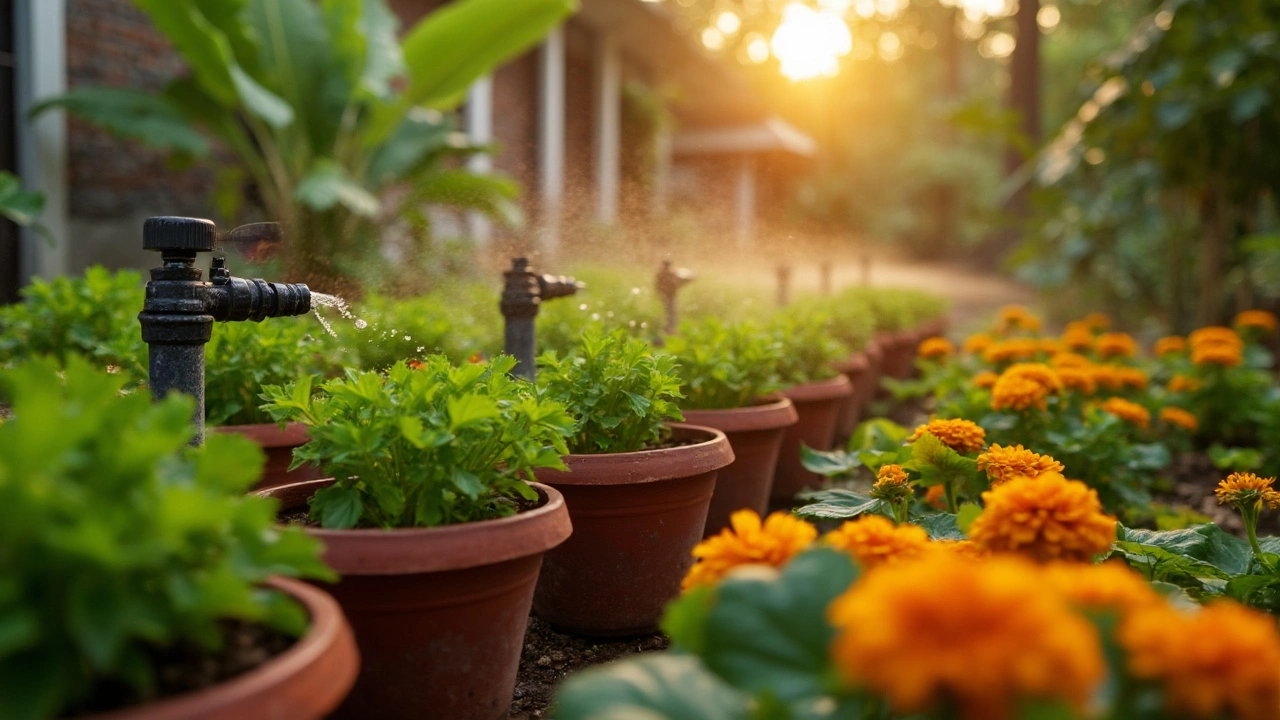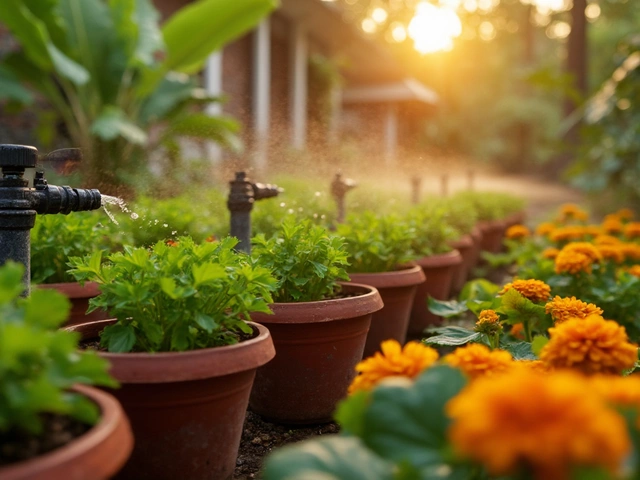You know when you grab a hose and flood your garden, thinking the plants look thirsty? That method wastes more water than you realise, and honestly, your garden isn’t thanking you for it. Today, the real game-changer in watering is the slow, targeted drip. But, if you’ve shopped for garden watering solutions, you’ve probably seen both “drippers” and “emitters”—and the jargon alone is enough to make your head spin. Aren’t they just tiny plastic things that let water drip out? Not quite. Knowing the difference actually matters for your garden, your water bill, and your sanity.
What Actually is a Dripper? And an Emitter?
Let’s cut through the confusion. Both drippers and emitters are little gadgets you connect to irrigation tubing to release water slowly. The common ground? Each sends water right where your plants need it: down to the roots. But their design, function, and best uses do differ—a lot more than most people think.
Drippers are usually the classic, button-shaped devices you see poked into black tubing zigzagging through people’s flower beds. Each dripper lets out a precise, controlled amount of water. Where you place them is where the water goes, with next to zero spray or mess. The signature of a dripper is its fixed flow rate—often measured in litres per hour (lph).
Emitters, on the other hand, is a broader term—like saying “vehicle” instead of “bicycle.” Most of the time in shops, “emitter” still refers to something that delivers water in a regulated way, but not always with the same precision or shape as a classic dripper. Emitters can include drippers, micro-sprayers, mini-bubblers, and more. Basically, it’s an umbrella word, and drippers are a type of emitter. Confusing? A bit, but think of emitters as everything that controls the rate of water flow by design—not just the ‘plain button drippers’ but other options that spit, mist, or bubble the water around too.
If you want a number, a standard dripper releases water anywhere from 2 to 8 litres per hour, targeted to the plant base. Micro-sprayer emitters might cover a small radius with a gentle fan or spray, often at a slightly higher flow rate. Bubblers push out even more, suitable for thirsty hedges or small trees. The defining feature is the style of delivery and the volume.
What trips up most people is how sellers and brands use the terms. In the USA and Australia, ‘emitter’ is the technical term, while in the UK, most garden shops will still say ‘dripper’ for stand-alone units and use ‘emitter’ for multi-outlet systems or anything that isn't a classic button dripper. So, when you’re buying supplies in the UK, know what you’re getting—a button dripper for pots, a sprayer emitter for ground cover, and a bubbler emitter for big shrubs.
| Type | Average Flow Rate (L/hour) | Coverage Area | Best For |
|---|---|---|---|
| Dripper | 2-8 | Direct to base | Veg, pots, most beds |
| Micro-Spray Emitter | 15-50 | Wide radius (0.5-1m) | Ground cover, lawns |
| Bubbler Emitter | 30-120 | Small basin | Trees, shrubs |
Here’s an odd fact: Drippers were first developed out of necessity in Israel in the 1960s, to cope with extreme water shortages. They found giving each plant a little timed drink is astronomically more efficient. Now, 95% of commercial greenhouses worldwide rely on various emitters to grow crops—you can thank drippers for those perfect supermarket tomatoes.
Here in Brighton, a study at the University of Sussex found gardens using drippers used 60% less water per month in summer compared to gardens watered from a hose. Less water, better results, and (bonus) fewer weeds—since dry areas don’t encourage stray seeds. The right delivery device gives you targeted hydration where it matters.
There’s a famous quote in the irrigation world by engineer Simcha Blass, inventor of the original dripper:
“A trickle at the root can do more than a flood on the leaves.”No matter your plant, that lesson sticks. Blass’s dripper idea turned into an industry—it’s worth knowing if you’re trying to copy the pros.

Choosing Between Drippers and Emitters: Which Suits Your Garden?
If you’ve stood in a garden centre feeling overwhelmed by options, you’re not alone. The real question is: what do you want to water, and how much control do you want over water use? That’s where the difference comes into play in a real, practical sense.
Drippers are perfect for individual plants. If you’ve got pots, raised veg beds, or a border full of distinct perennials, a dedicated dripper to each root zone nails the job. Want to save water and avoid encouraging slugs by keeping leaves dry? Drippers are your go-to. You stick them in wherever you need, plug them to mainline tubing, and you’re sorted. No complicated adjustments—just reliable, slow hydration.
But let’s say you’ve got bedding packed tightly, a patch of thirsty strawberries spreading sideways, or want to cover a swathe of new seedling lawn. That’s where emitters in the broader sense shine, like micro-sprayers, foggers, or bubblers. These cast water within a wider area, so your ground cover or seedlings all get watered without precise targeting. You lose a tiny bit of water to evaporation, but it’s miles better than hand-hosing for 40 minutes every evening.
Your climate plays a role, too. Brighton isn’t exactly the Sahara, but hot spells catch gardens out in July and August. Gardens with sandy or stony soil love slow, low-volume drippers that stop water running away. But heavier clay can cope with micro-sprayers, as that soil soaks up a bigger burst without as much runoff.
Another tip? Check the pressure ratings. Drippers need a certain pressure to work best—most UK garden drippers are designed for 1-2 bars of pressure, since that’s what you get from an outdoor tap. But some emitter devices (especially micro-sprays and bubblers) might need pressure-compensating units if your garden’s on a slope, so the end plants don’t get a dribble.
Dripper systems can clog if you’ve got hard water or use dirty rainwater from a water butt. A simple filter fitted at the tap (some cost less than a tenner) boosts reliability. Pop the drippers off once a year and soak them in a vinegar solution if you spot any uneven flow. For emitters with moving parts like sprayers, an annual rinse and check-up goes a long way. Reliability means years of fuss-free watering.
One mistake to avoid: spacing. People put drippers miles apart, thinking one will water a cluster. Unless your soil is pure sponge, water rarely spreads more than 20cm sideways from any dripper point. If you’re using emitters, measure the radius accurately—manufacturers are pretty honest about range on the box. If a micro-sprayer says it covers half a metre, that’s the max—don’t expect more.
And don’t skimp on timers. Electronic timers make a big difference by automating the system. Set them up at dusk or dawn to lose less water to evaporation. Most plants want a deep drink a couple of times a week, not daily sprinkles. Tomatoes and peppers, for example, get cranky with too much or too little water—but consistent dripper-fed schedules mean fewer split fruits and more reliable harvests.
Sustainability is a selling point: The British Ecological Society reports that efficient drip and emitter systems cut urban water use by up to 50%. Figure out what your plants crave and connect the right gadget for the job—your wallet and the planet both win.

Installing and Maintaining Drippers and Emitters: Practical Tips for Real Gardens
If you’re thinking, "All right, I want in—but how complicated is it?", don’t panic. Setting up either drippers or emitters sounds more technical than it really is, like flat-pack furniture but with less swearing. You only need a few bits: main supply tubing, connectors or tees, your chosen drippers or emitters, and anchor stakes. A punch tool helps poke holes where you want the gadgets to go. Snip, connect, and push—that’s the order.
Start by laying out the main tubing where you want the water to run. Use a tape measure if you’re fussy, or just guesstimate the lines beside plant rows. Then grab the punch tool and poke a hole at each plant for drippers, or spaced out for emitter coverage (like every 50cm for sprayers).
Once your system is in, turn it on and check for leaks or wonky flows. Water spurting sideways? Nudge the dripper in deeper or check for blockages. Monthly check-ups help if you’re using a rain barrel, as muck can block the finer holes in drippers fast.
In Brighton’s briny air, stuff corrodes faster than you’d expect. If your emitters or drippers have metal bits, treat them with silicone grease once a season. UV light from the sun makes plastic brittle over years—if you see cracks, switch them before next summer.
For raised beds or pots, mount drippers higher so water dribbles down through the soil—don’t just “poke and hope.” You want to see a dark, wet spot under each dripper, about the size of a grapefruit. If you use emitters for wide areas, watch for puddling—dial down the flow or shift the emitter so every root zone gets a fair share. Read your plants: wilting means not enough, yellowing means too much.
A clever move is setting up groups: the thirstiest plants on one line, the drought lovers on another. Modern timers allow you to water each zone at different times. So your lettuce patch can get an evening mist while your lavender sits dry, as it prefers. Pay attention to the weather—turn your system off if there’s proper rain, or add a cheap rain sensor that does it for you.
If you geek out over gadgets, smart irrigation is taking off. WiFi-controlled timers can be managed from anywhere you get reception. Some even pull in up-to-date weather forecasts and adjust the schedule, so you don’t waste a drop. That’s a big selling point—especially with unpredictable UK summers. But honestly, even the simplest battery-powered timers and classic dripper or emitter setups will do 90% of the work for most home gardeners.
For larger gardens, you might want a pressure regulator. Drip systems hate extremes—too little pressure, and drippers dribble; too much, and emitters pop off. Aim for that Goldilocks zone (about 1.5 bar is perfect in most gardens). A quick pressure check avoids endless faff and wasted water.
If you’re frustrated by tangled hoses, patchy beds, or the endless guilt trip of thirsty midsummer plants, switching to a simple dripper or emitter system frees up your evenings for something more fun. Most kits last for years—especially if you bring them in for winter or flush the lines before the first freeze. As Simcha Blass showed, clever water delivery is everything. Whether you go for a classic dripper or try a wide-coverage emitter, the difference is more than a word—it’s the secret to happy, no-fuss plants and a greener conscience.


